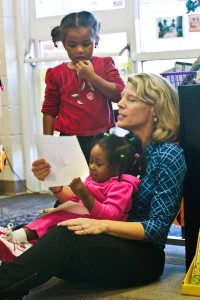As is almost always the case when large disasters strike, kids suffered disproportionately in 2011 in the face of earthquakes, tsunamis, floods and tornadoes. While the biggest disasters were the tsunami and earthquake in Japan and the resulting nuclear reactor crisis in March, and the Horn of Africa hunger crisis that got the world’s attention this summer, there were more than 20 emergencies in 2011 to which Save the Children and other relief and recovery agencies responded. And in all of them around the world, children bore the brunt of the suffering.
In Japan, where more than 15,000 thousand people died and close to 400,000 lost their homes, children and the elderly were hit hard, given the demographics of the northern coast. Many children lived for weeks in shelters and—though the response by the Japanese government was swift—the impact was painful for children who had lost all their possessions and sometimes family members and friends. Save the Children’s response focused on helping kids transition back to school and we continue to work with local organizations to make sure children’s needs are met, with a special focus on supporting child care for working families. Just like our work in the United States following Hurricane Katrina, we will also focus on making sure future emergency responses in Japan pay more attention to the specific needs of children, working with local government officials as well as community organizations.
A very different emergency unfolded over the summer across the Horn of Africa, where the worst drought in 60 years hit Somalia, Ethiopia and Kenya. I visited Dadaab, the largest refugee camp in the world in August, when 1,200 people per day—more than half of them children—were streaming into the camp in search of food, water, and safety. I met a few children who had traveled days on their own or with strangers. Some parents sent their children with relatives or alone to make the dangerous crossing from Somalia to Kenya . As a mom of three children, I can’t imagine anything worse than having to turn your children away to save their lives, or to decide to leave a dying child behind to save another. No parent should have to make that choice.
Save the Children has reached more than 2.1 million people with help in these three African countries in 2011, and the response is not over yet. While the rains have started in some of the hardest-hit regions in the Horn, the malnutrition rates for children continue to be horrendously high. We will continue to provide relief to tens of thousands of families throughout 2012.
Right here in the United States, a series of deadly tornadoes of historic proportion hit Alabama, Mississippi and Missouri in late spring and early summer. Save the Children helped serve children in shelters, working with the Red Cross and other partners to ensure that children who had lost everything had some measure of comfort and a safe place to stay. And we continue to support hardest-hit Alabama with emotional recovery programs for children and caregivers. The work we did following Katrina is paying off, with much more attention to kids’ needs before, during and after these disasters– more than we had ever seen. While it takes years for these new ways of working to be part of disaster response systems inside states, we could see they were making a real difference for real kids. Yet only 17 states meet all four of our basic preparedness and safety standards to protect kids in schools and child care facilities during a disaster. There is still more to do. 
And that’s one of our biggest continuing challenges in our emergency work – to respond to emergencies while at the same time trying to prepare for or mitigate the underlying factors that cause them. For almost a decade we have been working in Ethiopia to help pastoralists (people who make a living from their sheep, goats, cattle, and camels and move with their animals from place to place) to withstand periodic droughts and better predict when longer droughts are coming. Our efforts on food security and coping mechanisms helped Ethiopians help themselves through the Horn of Africa drought with the proper knowledge and tools. This advanced planning helped tens of thousands of Ethiopians escape hunger and death during the recent crisis.
It is widely believed that many more would have died in Japan without the warning system and rapid response mechanisms the Japanese government has developed over decades. It is hard and often unrecognized work, but it is the key to saving millions of lives when disasters strike. And it is work that Save the Children will be spending more and more time and effort on as the number of disasters seems to climb each year.
With the help of our many supporters throughout the world, we raised almost $150 million for emergency work in 2011 and saved and improved millions of lives. No one can predict the future, and I don’t know what 2012 has in store for me or for the children of the world. But I do know that we will work to prepare families to face the challenges ahead, to safeguard the wellbeing of children in crisis and to make 2012—and every year following—a better time to be a child.


